
Preserve Prairies, Save Savannas
The Southern Driftless Grasslands (SDG) partnership is initiating a regional project in southwest WI to assess and evaluate the prairie and savanna remnants across the SDG landscape.
We seek landowners who have (or think they have) pockets of native prairie on their lands and/or have oak forests of open grown oaks on their property.
Our goals for this project are:
-
Build relationships that help the landowner and help the land.
-
Connect landowners with partner programs that provide financial assistance to rid prairies and savannas of invasive brush and weeds and get prescribed fire back on the land.
-
Establish a real-time understanding of the condition, restorability, and location of prairie and savanna remnants within southwest Wisconsin.
Learn more about identifying a prairie and savanna remnant by using these buttons.
Do you have a potential or known prairie and/or savanna remnant on your land? Request a site visit and remnant assessment!

Native Prairie
Prairies are characterized by a lack of trees and shrubs and an abundance of grasses. They are dependent on intermittent fires to maintain their open structure and promote germination and growth of native plants. They can occur on a wide variety of soil types and soil moisture levels.
The key to finding any prairie is to locate areas that were never plowed and not too heavily grazed. Dry prairie remnants are usually found on steep and rocky hillsides, areas of thin soil, and south and west-facing slopes. These are the prairies we are most likely to recover.
Mesic prairies tend to be found in moist fertile soils on more level terrain, but are extremely rare. Best places to find a mesic prairie is along roadsides and railroad tracks, where they escaped the plow.
Wet prairies occur in lowland areas subjected to frequent flooding, especially along streams or in association with springs and seeps.
Prior to European settlement, approximately 2.1 million acres of prairie existed in WI. Today, less than 0.1% of Wisconsin’s prairies remain. Prairie loss is not only a Wisconsin issue, but in fact, tall grass prairies (mesic and wet-mesic prairies) are one of the most endangered ecosystems on Earth. In Wisconsin most prairies were converted to row crops, grazed, altered through fire suppression or invaded by woody and invasive species.
Birds: Henslow’s sparrow, bobolink, dickcissel, savanna sparrow
Mammals: Franklin’s ground squirrel, prairie vole, least weasel
Reptiles & Amphibians: ornate box turtle, pickerel frog
Plants: prairie bush clover, HiIl’s thistle, pale purple coneflower
Native prairies support many species whose populations are in decline, including:
Oak Savanna

Oak savannas are described as having less than 50% canopy cover from burr and white oak, with a wide variety of grasses and wildflowers growing underneath. Under and between the oaks grow a mixture of sun-loving woodland plants, and true savanna plants that prefer dappled sunlight.
The openness of the oak savanna is usually maintained by fire, and of the major tree species in the Midwest the oaks are uniquely fire resistant. Over time, these scattered oaks develop into large trees and each open-grown tree receives maximum sunlight and there is little competition between individuals. Oak savannas generally develop in drier areas, on south- or southwest-facing slopes or other areas where many other tree species are unable to compete.
Oak savannas can be identified by their scattered open-grown oak trees with an open understory. The oak trees have a large, full canopy with many strong lower limbs that stretch outward rather than upward, and often short, stocky trunks. Oak trees alone do not make oak savanna ecosystems, though the trees themselves are historic. Some open-grown oak trees have been dated back to 1780! An oak savanna ecosystem will also have wildflowers such as yellow pimpernel, elm-leaved goldenrod, horse gentian, and woodland boneset to name a few.
Historically, oak savannas were found on upland soils in areas subjected to frequent fires. Today, seek out wide spreading oaks in lightly grazed pastures and look for native grasses and wildflowers, or look for wide spreading oak trees. Oak savannas are commonly choked with prickly ash, brambles, and invasive species such as honeysuckle and common buckthorn. These can hide the open growth character of the oak trees.
Prior to European settlement, WI had an estimated 5.5 million acres of oak savanna. Today less than 1% remain, and those that do represent one of the most threatened ecosystems on Earth. Many oak savannas were lost to land conversion for row crops, logging of trees for timber, and development.
With the suppression of regular fire, invasive species such as buckthorn, honeysuckle, and garlic mustard have invaded acres of savanna habitat, and heavy grazing and conversion to pasture has led to the loss of the native diversity associated with a healthy oak savanna.
The oak savanna was once one of the most common vegetation types in the Midwest but is today highly endangered. Intact oak savannas are now one of the rarest plant communities on earth, however, many degraded oak savannas still remain and can be restored.
Birds: red-headed woodpecker, brown thrasher, field sparrow
Mammals: woodland vole, Franklin’s ground squirrel
Reptiles & Amphibians: Blanding’s turtle, prairie racerunner
Plants: purple milkweed, wild hyacinth
Savannas support many species whose populations are in decline, including:

























